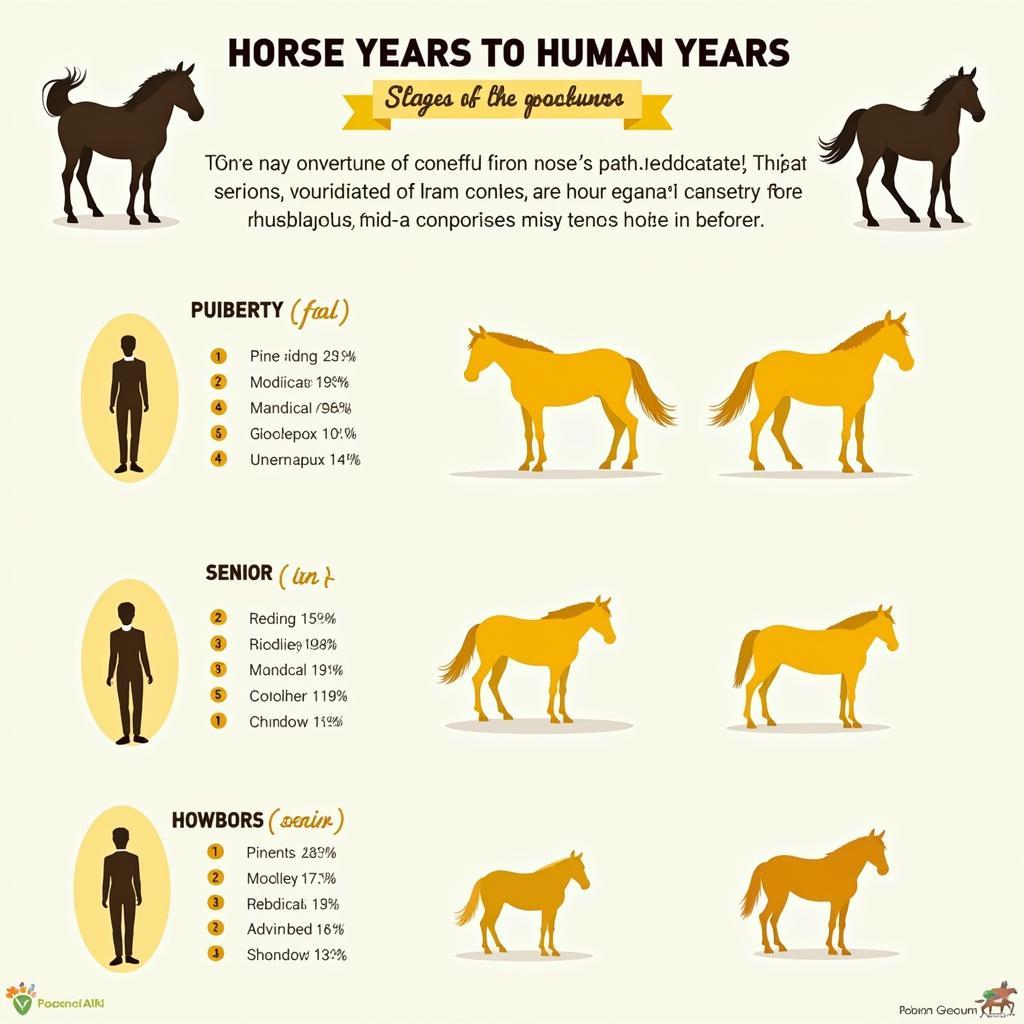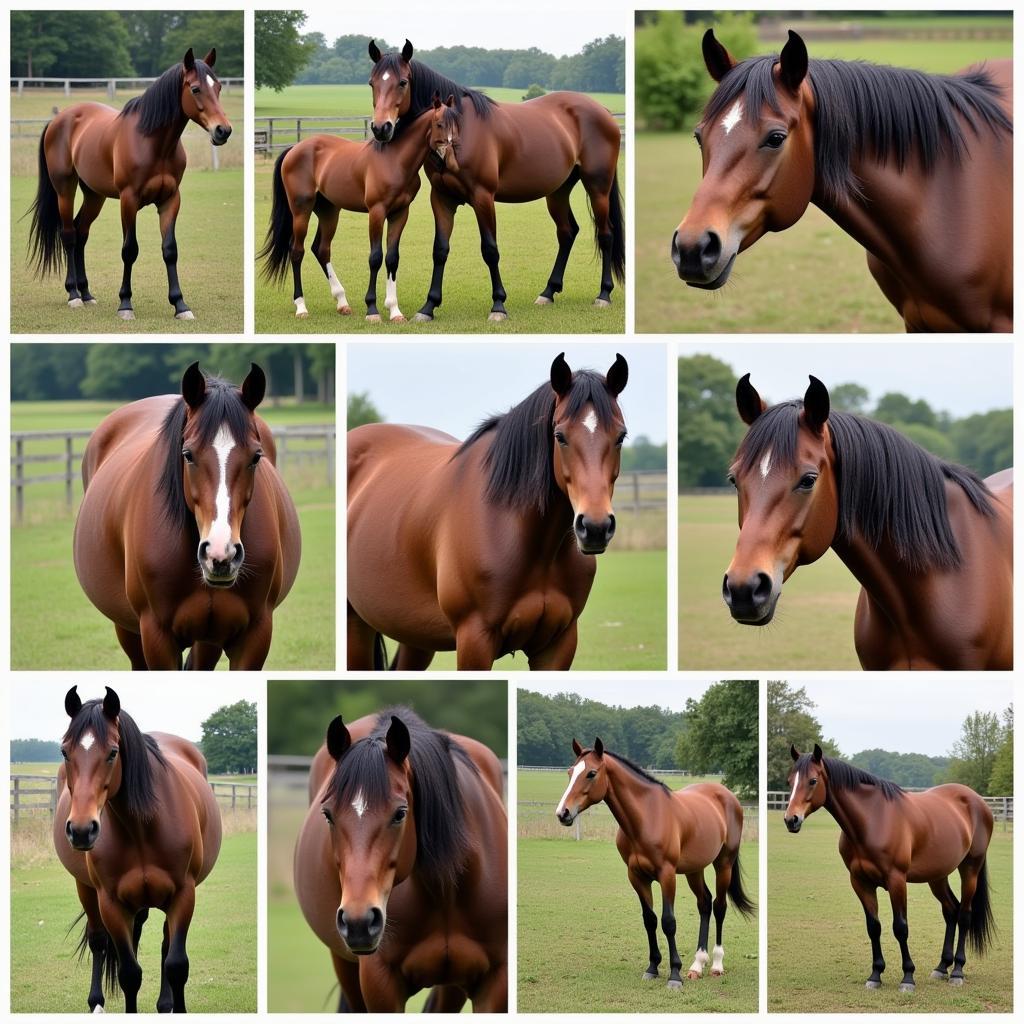Understanding the relationship between horse years and human years is crucial for every horse owner. This comparison helps us better grasp a horse’s life stages and adjust our care accordingly, ensuring our equine companions live long, healthy lives. Let’s delve into the complexities of equine aging and debunk some common myths.
 Horse and Human Years Comparison Chart
Horse and Human Years Comparison Chart
Many people believe in a simple 1:7 ratio, where one horse year equals seven human years. However, this oversimplification doesn’t accurately reflect the nuances of horse development. While a horse may mature much faster in its early years, the aging process slows down considerably as they get older. For instance, a one-year-old horse is roughly equivalent to a six-year-old human in terms of physical maturity, already capable of being ridden lightly. By the time a horse reaches four, it’s considered an adult, comparable to a human in their mid-twenties.
Decoding the Equine Aging Process
A more accurate comparison uses a multi-stage system that considers the rapid growth and development in the first few years, followed by a more gradual aging process. This approach provides a more nuanced understanding of a horse’s life stages, from foal to senior. It’s important to note that these are still estimates, and individual horses may mature at slightly different rates. Factors like breed, size, and overall health can influence the aging process.
Key Stages of Horse Development
The early years of a horse’s life are marked by rapid growth and development. Foals go from wobbly newborns to playful youngsters in a matter of months. This rapid development is reflected in the horse years vs. human years comparison, where the first year of a horse’s life is equivalent to several human years. barbless wire for horses are recommended to protect young horses from injury.
As horses mature, their growth slows down, and the aging process becomes more gradual. Adulthood, typically reached between four and six years of age, marks a period of relative stability in the horse years vs. human years comparison. This is the prime of a horse’s life, often the time they are at their peak performance for riding and other activities.
How Old Is Your Horse in Human Years?
While the multi-stage comparison provides a more accurate representation of horse aging, it can still be confusing to remember all the different stages. Several online resources and charts are available to help you easily convert your horse’s age into human years. These resources often provide additional information on the typical physical and behavioral changes associated with each life stage.
Common Misconceptions About Horse Age
One common misconception is that older horses are automatically less capable. While senior horses may require some adjustments in their care and exercise routines, many remain active and enjoy a good quality of life well into their twenties and even thirties. Providing appropriate care, including joint supplements like acti-flex joint supplement for horses, can greatly contribute to a senior horse’s well-being.
“Regular veterinary checkups are crucial for older horses,” says Dr. Emily Carter, DVM, specializing in equine geriatrics. “Early detection of age-related issues can significantly improve a horse’s quality of life and potentially extend their lifespan.”
Understanding Your Horse’s Needs at Every Age
Understanding the relationship between horse years and human years allows horse owners to tailor their care and management practices to the specific needs of their horses at each life stage. From nutrition and exercise to healthcare and training, every aspect of horse care should be adjusted to accommodate the horse’s age and developmental stage.
 The Different Life Stages of a Horse
The Different Life Stages of a Horse
“Knowing where your horse is in its life cycle helps you anticipate potential health issues and provide proactive care,” adds Dr. Carter. “This includes adapting their diet, exercise routine, and even their social interactions to support their overall well-being.” Are Clydesdales the biggest horses? Learn more about different breeds and their characteristics in our article are clydesdales the biggest horses. You may also wonder, can deer eat horse feed? We answer this and other common questions on our website. Lastly, understanding how a horse snap can help inform how to train your horse properly.
Knowing the accurate correlation between horse years and human years allows us to better appreciate the lifespan of these magnificent creatures. This knowledge empowers us to make informed decisions regarding their care, ensuring they live healthy, happy lives at every stage. It’s essential to remember that the Horse Years Vs Human Years comparison is a guideline, not an absolute rule. Individual horses may mature and age at different rates.
FAQ
- What is the average lifespan of a horse?
- How do I determine my horse’s age?
- What are the signs of aging in horses?
- How should I adjust my horse’s care as they age?
- Are there specific health concerns for senior horses?
- What are the benefits of understanding horse years vs. human years?
- Where can I find more resources on equine aging?
For further assistance, please contact us at Phone Number: 0772127271, Email: [email protected], or visit us at QGM2+WX2, Vị Trung, Vị Thuỷ, Hậu Giang, Việt Nam. We have a 24/7 customer service team ready to help.